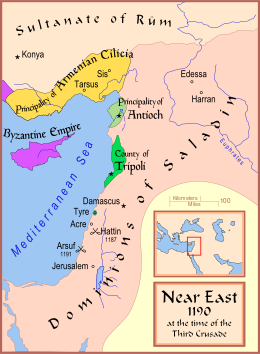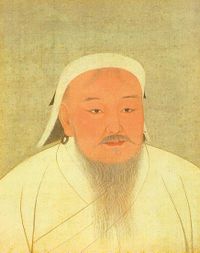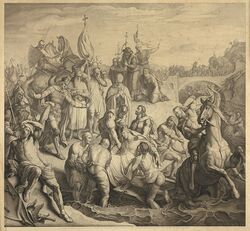1190
► | قرن 11 | << قرن 12 >> | قرن 13 | ◄
► | عقد 1160 | عقد 1170 | عقد 1180 | << عقد 1190 >> | عقد 1200 | عقد 1210 | عقد 1220 | ◄
► | ► | 1185 | 1186 | 1187 | 1188 | 1189 | << 1190 >> | 1191 | 1192 | 1193 | 1194 | 1195 | ◄ | ◄
تحويل 1-1-1190م الى هجري (وصلة خارجية) | تحويل 31-12-1190م الى هجري (وصلة خارجية) | ابحث في الموسوعة عن مواضيع متعلقة بسنة 1190
| الألفية: | الألفية 2 |
|---|---|
| القرون: | القرن 11 - القرن 12 - القرن 13 |
| العقود: | عقد 1160 عقد 1170 عقد 1180 - عقد 1190 - عقد 1200 عقد 1210 عقد 1220 |
| السنوات: | 1187 1188 1189 - 1190 - 1191 1192 1193 |
| 1190 حسب الموضوع | |
| السياسة | |
| زعماء الدول – الدول ذات السيادة | |
| تصنيفات المواليد والوفيات | |
| المواليد – الوفيات | |
| تصنيفات التأسيسات والانحلالات | |
| التأسيسات – الانحلالات | |
| الفنون والآداب | |
| 1190 في الشعر | |
| التقويم الگريگوري | 1190 MCXC |
| آب أوربه كونديتا | 1943 |
| التقويم الأرمني | 639 ԹՎ ՈԼԹ |
| التقويم الآشوري | 5940 |
| التقويم البهائي | −654 – −653 |
| التقويم البنغالي | 597 |
| التقويم الأمازيغي | 2140 |
| سنة العهد الإنگليزي | 1 Ric. 1 – 2 Ric. 1 |
| التقويم البوذي | 1734 |
| التقويم البورمي | 552 |
| التقويم البيزنطي | 6698–6699 |
| التقويم الصيني | 己酉年 (التراب الديك) 3886 أو 3826 — إلى — 庚戌年 (المعدن الكلب) 3887 أو 3827 |
| التقويم القبطي | 906–907 |
| التقويم الديسكوردي | 2356 |
| التقويم الإثيوپي | 1182–1183 |
| التقويم العبري | 4950–4951 |
| التقاويم الهندوسية | |
| - ڤيكرام سامڤات | 1246–1247 |
| - شاكا سامڤات | 1112–1113 |
| - كالي يوگا | 4291–4292 |
| تقويم الهولوسين | 11190 |
| تقويم الإگبو | 190–191 |
| التقويم الإيراني | 568–569 |
| التقويم الهجري | 585–586 |
| التقويم الياباني | Bunji 6 / Kenkyū 1 (建久元年) |
| تقويم جوچى | N/A |
| التقويم اليوليوسي | 1190 MCXC |
| التقويم الكوري | 3523 |
| تقويم مينگوو | 722 قبل جمهورية الصين 民前722年 |
| التقويم الشمسي التايلندي | 1733 |
Year 1190 (MCXC) was a common year starting on Monday (link will display the full calendar) of the Julian calendar.
أحداث
حسب المكان
الامبراطورية البيزنطية
- Spring - A German expeditionary force (some 15,000 men) led by Emperor Frederick I (Barbarossa) marches towards Constantinople، on the way to the Holy Land. Emperor Isaac II (Angelos), suspicious that Frederick is planning to conquer Constantinople, attempts to stop him by attacking the Crusaders. The German forces are too strong and they capture Adrianople. A peace treaty is signed by both Isaac and Frederick, that ensures the Germans are given supplies, and free passage through to Palestina.[1]
- Isaac II starts a campaign against the Bulgarians, who claim their independence. After passing the Balkan Mountains، Isaac marches westward to besiege Tarnovo، the new Bulgarian capital. Meanwhile, the Byzantine fleet reaches the Danube River in order to block the way of Cuman reinforcements from the North. The defense of Tarnovo is led by Ivan Asen I، emperor (Tsar) of Bulgaria. After spreading rumors of the arrival of a Cuman army to relieve the city, Isaac orders to retreat to Stara Zagora.
- Battle of Tryavna: Byzantine forces under Isaac II are ambushed and defeated by the Bulgarians in a mountain pass, near Tryavna. In panic, the Byzantines break up and begin a disorganized retreat. Isaac barely escapes, his Varangian Guard has to cut a path through their own soldiers, enabling their emperor's flight from the rout. The Bulgarians capture the imperial treasure, including the golden helmet of Isaac, his crown, and the Imperial Cross which contains a wooden piece of the Holy Cross.
الحملة الصليبية الثالثة
- March - Frederick I leaves Adrianople to Gallipoli at the Dardanelles to embark, with the help of Byzantine transports, to cross into Asia Minor. On April 25، he enters territory of the Seljuk سلطنة الروم under the rule of Sultan Kilij Arslan II. Although promised to let the German Crusaders pass peaceably through his domains, Kilij Arslan harasses Frederick's forces with hit-and-run attacks. On May 7، a Turkish army (some 10,000 men) is defeated at the Battle of Philomelion، by 2,000 Crusaders.[2]
- March 25 - Conrad of Montferrat sails south with a Crusader fleet (some 50 ships) from Tyre. As Conrad's fleet approaches the harbour of Acre، an equally sized Muslim fleet sorties out to meet the Crusaders in open battle. Eventually, the Ayyubid fleet is blockaded (supported by Danish and Pisan ships) in the port. Acre is again cut off from reinforcements; the city's supplies are exhausted, and the Muslim garrison has to resort to eating their own beasts. In the event, troops are driven to cannibalism.[3]
- April - Muslim forces under Saladin capture Beaufort Castle after a long siege from Reginald of Sidon who has offered to hand over the castle to Saladin on the condition that he has three months to remove his family to a place of safety. At the end of the three months, Saladin expects the castle to be handed over but finds that Reginald has used the time to strengthen the castle against a siege. He is imprisoned at Damascus – the castle's garrison finally surrenders in return for Reginald's release.[4]
- May 5 - Siege of Acre: A Crusader force under King Guy of Lusignan attacks the city with three siege engines, but all are destroyed by the Muslim defenders with Greek fire، a highly flammable liquid. An Egyptian flotilla is able to avoid the Pisan fleet (some 50 ships) and resupply the city with new provisions. Saladin launches a massive eight-day attack on the Crusaders two weeks later. Meanwhile, in the Crusader camp the conditions are deteriorating by disease and famine، among the soldiers.[5]
- May 18 - Battle of Iconium: German forces under Frederick I defeat the Seljuk army (40,000 men) in a pitched battle. They are routed, leaving the city at the mercy of the German Crusaders. Frederick does not pursue the Seljuks, because his forces have been weakened by food shortage for the previous weeks. His 23-year-old son, Frederick VI، takes Iconium (modern-day Konya) and proceeds to massacre the citizens. The Germans take booty amounting to 100,000 marks in the Turkish capital.[6]
- June 10 - Frederick I drowns while crossing (or bathing in) the Göksu River near Selucia (modern-day Silifke) in Armenian Cilicia. The German Crusaders are demoralized and exhausted by the summer heat, Frederick VI takes over the command of his father, carrying with him the emperor's body preserved in a barrel of vinegar. Some of the German nobles decide to return home with their followers; Frederick continues with his army (some 5,000 men) and eventually reaches Antioch، on June 21.[7]
- September 24 - A Crusader fleet attempts to destroy the Tower of Flies at Acre, which guards the city's harbour, by ramming vessels loaded with combustibles into it. At a critical moment, the ships collide with one another and are badly damaged. A specially built Pisan vessel resembles a floating castle and outfitted with mangonels, is set afire during a sortie from the harbour by a Muslim flotilla.[8]
- November 24 - The 18-year-old Isabella I، half-sister of Sibylla, Queen of Jerusalem، marries Conrad of Montferrat at Acre making him de facto king of Jerusalem (as Conrad I). He has the support of her mother Maria Comnena and stepfather Balian of Ibelin، as well as Reginald of Sidon and other major nobles in the Crusader States.
- The Teutonic Order is founded at Acre by German knights of Lübeck and Bremen. The Order is formed to aid Christians on their pilgrimages to the Holy Land and to establish hospitals (تاريخ تقريبي).
أوروبا
- July 4 - King Richard I (the Lion Heart) and Philip II (Augustus), meet at Vézelay and agree to divide the spoils of the Crusade equally between themselves. They march to the coast and then make their way across the Mediterranean، taking different routes. Richard travels with an expeditionary force (some 17,000 men) via Marseille and Philip travels with a smaller contingent (some 15,000 men) via Genoa. Richard has some 100 ships at his disposal, several of which are from Norman ports, others from Shoreham and Southampton.[9]
- September - Richard I arrives in Sicily at the head of a Crusader army and demands the release of his sister Joan of England، queen of Sicily, who is held hostage by the usurper Tancred of Lecce. He also demands that Tancred fulfills the financial commitments made by the late King William II (the Good) to the Crusade. Tancred refuses the financial demand but he agrees to release Joan, on September 28.[10]
- October 4 - Richard I captures Messina، after looting and burning the city he establishes his base there. Richard insists that his own banner be erected over the city, but this creates tension between Richard and Philip II, who has joined him with his forces. Tancred accepts a peace agreement, and pays Richard 20,000 ounces of gold. Friendly relations are restored, Richard agrees to split the gold with Philip.[11]
- King Henry VI، eldest son of Frederick I, grants Henry I (the Brave) the title of Duke of Duke of Brabant. Henry tries to expand his power and soon quarrels with Count Baldwin V، duke of Hainaut.
- December - Richard I and Philip II stay in Sicily over the winter months waiting for the weather to improve before continuing their journey to the Holy Land.
- Siege of Silves – the Almohad caliph, Abu Yusuf Yaqub al-Mansur، fails to reconquer Silves, Portugal.[12]
إنگلترة
- لندن adopts the Cross of St. George، the red cross on a white background. The flag is also used by the fleet of Genoa، and allows the ships from London to use the flag for protection when they enter the Mediterranean on trading missions.
- 18 مارس - A massacre and mass-suicide of the Jews in York، results in the deaths of 150–500 Jews in Clifford's Tower.
آسيا
حسب الموضوع
الفنون والعلوم
- On the Harmony of Religions and Philosophy (ar. كتاب فصل المقال), by Averroes، is first published.
- Speculum Virginum, a German manuscript, is published (تاريخ تقريبي).
التعليم
- Emo of Friesland، a Frisian scholar and abbot، commences his study at what will become the جامعة أكسفورد.
الدين
- Cartmel Priory is founded by William Marshal، 1st Earl of Pembroke، in England.
- King Stefan Nemanja founds the Studenica Monastery in Serbia.
مواليد
- July 24 - Yelü Chucai، Chinese statesman (ت. 1244)
- 30 ديسمبر - ابن أبي الحديد، دارس عربي (ت. 1258)
- Benedetto Sinigardi، Italian Franciscan friar (ت. 1282)
- Gerhard II of Lippe، German archbishop (ت. 1258)
- Heinrich I von Müllenark، German archbishop (ت. 1238)
- Helvis of Cyprus، princess of Antioch (تاريخ تقريبي)
- Henry II of Bar، French nobleman and knight (ت. 1239)
- Ida of Nivelles، Belgian Cistercian nun and mystic (ت. 1231)
- John (the Old), French nobleman and knight (ت. 1267)
- Klement of Ruszcza، Polish nobleman and knight (ت. 1256)
- Luce de Gast، English nobleman (تاريخ تقريبي)
- Maria of Brabant، Holy Roman Empress (ت. 1260)
- Peter González (or Pedro), Castilian priest (ت. 1246)
- Pietro della Vigna، Italian jurist and diplomat (ت. 1249)
- Richer of Senones، French monk and chronicler (ت. 1266)
- Roger I of Fézensaguet، French nobleman (ت. 1245)
- Sayf al-Din al-Bakharzi، Persian theologian (ت. 1261)
- Sorghaghtani Beki، mother of Kublai Khan (ت. 1252)
- Tbeli Abuserisdze، Georgian scholar and writer (ت. 1240)
- Theodora Angelina، Byzantine noblewoman (ت. 1246)
- Vincent of Beauvais، French encyclopedist (ت. 1264)
- William Marshal، English nobleman and knight (ت. 1231)
- William Perault، French preacher and writer (ت. 1271)
- Władysław Odonic، duke of Greater Poland (ت. 1239)
- Yuan Haowen، Chinese politician and poet (ت. 1257)
- Zulema L'Astròloga، Moorish astronomer (تاريخ تقريبي)
وفيات
- February 18 - Otto II (the Rich), margrave of Meissen (و. 1125)
- March 15 - Isabella of Hainault، wife of Philip II (Augustus) (و. 1170)
- March 23 - Saigyō Hōshi، Japanese monk, poet and writer (و. 1118)
- 10 يونيو - فردريك الأول (برباروسا)، الامبراطور الروماني المقدس (و. 1122)
- July 25 - Sibylla (or Sibylle), queen of Jerusalem (و. 1160)
- July 29 - Maud of Gloucester (or Matilda), English countess
- August 1 - Floris III، Dutch nobleman and knight (و. 1141)
- August 16 - Dedi III (the Fat), German nobleman (و. 1130)
- August 21 - Godfrey III، count of Louvain (House of Reginar)
- 13 سبتمبر - Herman IV، German nobleman (و. 1135)
- September 20 - Adelog of Hildesheim، German bishop
- October 16 - Louis III (the Mild), German nobleman
- November 3 - Diepold of Berg، German bishop (و. 1140)
- November 19 - Baldwin of Forde، English archbishop
- November 21 - Děpolt II (or Diepold), German nobleman
- Bernard II de Balliol، Norman nobleman (تاريخ تقريبي)
- كريتيان دى تروا، شاعر فرنسي، و trouvère وكاتب
- Geoffrey IV (the Younger), French nobleman and knight
- Judah ben Saul ibn Tibbon، Arab-Jewish translator (or 1191)
- Maria Komnene، queen of Hungary and Croatia (و. 1144)
- Ramon I de Montcada، Catalan nobleman (و. 1150)
- Ranulf de Glanvill، English Chief Justiciar and writer
- Robert de Beaumont (White-Hands), English nobleman
- Walkelin de Derby (de Ferrers), Norman nobleman
- Walter de Clifford (or FitzRichard), English nobleman
المراجع
- ^ Choniates, Nicetas (1984). O city of Byzantium: annals of Niketas Choniatēs. Translated by Magoulias, Harry J. Detroit: Wayne State University Press. p. 224. ISBN 0814317642. OCLC 10605650.
- ^ Loud, G. A. (2010). The Crusade of Frederick Barbarossa: The History of the Expedition of Emperor Frederick and Related Texts, p. 104. Farnham, Surrey: Ashgate Publishing. ISBN 978-0-75466-575-5.
- ^ Alan Ambrisco (1999). Cannibalism and Cultural Encounters in Richard Coeur de Lion, pp. 105–106. Journal of Medieval and Early Modern Studies.
- ^ Kennedy, Hugh (1994). Crusader Castles, pp. 43–44. Cambridge: Cambridge University Press. ISBN 0-521-42068-7.
- ^ Pryor, John H. (2015). A Medieval Siege of Troy: The Fight to the Death at Acre, 1189–1191, p. 108. Farnham, Surrey: Ashgate Publishing. ISBN 978-1-47241-958-3.
- ^ Loud, G. A. (2010). The Crusade of Frederick Barbarossa: The History of the Expedition of Emperor Frederick and Related Texts, pp. 110–111. Farnham, Surrey: Ashgate Publishing. ISBN 978-0-75466-575-5.
- ^ Steven Runciman (1952). A History of The Crusades. Vol III: The Kingdom of Acre, pp. 13–14. ISBN 978-0-241-29877-0.
- ^ Kenneth P. Czech. Third Crusade: Siege of Acre, p. 3. Originally published in August 2001. Military History Magazine.
- ^ Wolff and Hazard, p. 57[dead link]
- ^ Steven Runciman (1952). A History of The Crusades. Vol III: The Kingdom of Acre, p. 33. ISBN 978-0-241-29877-0.
- ^ Steven Runciman (1952). A History of The Crusades. Vol III: The Kingdom of Acre, pp. 34–35. ISBN 978-0-241-29877-0.
- ^ Picard, Christophe (1997). La mer et les musulmans d'Occident VIIIe-XIIIe siècle. Paris: Presses Universitaires de France.


